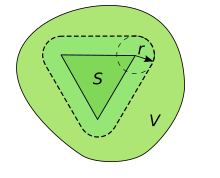En topología y áreas relacionadas de las matemáticas , un vecindario (o vecindario ) es uno de los conceptos básicos en un espacio topológico . Está estrechamente relacionado con los conceptos de decorado abierto e interior . Hablando intuitivamente, una vecindad de un punto es un conjunto de puntos que contienen ese punto donde uno puede mover una cierta cantidad en cualquier dirección lejos de ese punto sin salir del conjunto.
Definitions[edit]
Neighbourhood of a point[edit]
If is a topological space and is a point in , a neighbourhood of is a subset of that includes an open set containing
This is also equivalent to the point belonging to the topological interior of in
The neighbourhood need not be an open subset but when is open in then it is called an open neighbourhood.[1] Some authors have been known to require neighbourhoods to be open, so it is important to note conventions.
A set that is a neighbourhood of each of its points is open since it can be expressed as the union of open sets containing each of its points. A rectangle, as illustrated in the figure, is not a neighbourhood of all its points; points on the edges or corners of the rectangle are not contained in any open set that is contained within the rectangle.
The collection of all neighbourhoods of a point is called the neighbourhood system at the point.
Neighbourhood of a set[edit]
If is a subset of topological space then a neighbourhood of is a set that includes an open set containing . It follows that a set V is a neighbourhood of S if and only if it is a neighbourhood of all the points in S. Furthermore, V is a neighbourhood of S if and only if S is a subset of the interior of V. A neighbourhood of S that is also an open set is called an open neighbourhood of S. The neighbourhood of a point is just a special case of this definition.
In a metric space[edit]
In a metric space , a set is a neighbourhood of a point if there exists an open ball with centre and radius , such that
is contained in .
is called uniform neighbourhood of a set if there exists a positive number such that for all elements of ,
is contained in .
For the -neighbourhood of a set is the set of all points in that are at distance less than from (or equivalently, is the union of all the open balls of radius that are centred at a point in ):
It directly follows that an -neighbourhood is a uniform neighbourhood, and that a set is a uniform neighbourhood if and only if it contains an -neighbourhood for some value of .
Examples[edit]
Given the set of real numbers with the usual Euclidean metric and a subset defined as
then is a neighbourhood for the set of natural numbers, but is not a uniform neighbourhood of this set.
Topology from neighbourhoods[edit]
The above definition is useful if the notion of open set is already defined. There is an alternative way to define a topology, by first defining the neighbourhood system, and then open sets as those sets containing a neighbourhood of each of their points.
A neighbourhood system on is the assignment of a filter of subsets of to each in , such that
- the point is an element of each in
- each in contains some in such that for each in , is in .
One can show that both definitions are compatible, i.e. the topology obtained from the neighbourhood system defined using open sets is the original one, and vice versa when starting out from a neighbourhood system.
Uniform neighbourhoods[edit]
In a uniform space , is called a uniform neighbourhood of if there exists an entourage such that contains all points of that are -close to some point of ; that is, for all .
Deleted neighbourhood[edit]
A deleted neighbourhood of a point (sometimes called a punctured neighbourhood) is a neighbourhood of , without . For instance, the interval is a neighbourhood of in the real line, so the set is a deleted neighbourhood of . A deleted neighbourhood of a given point is not in fact a neighbourhood of the point. The concept of deleted neighbourhood occurs in the definition of the limit of a function and in the definition of limit points (among other things).
See also[edit]
- Neighbourhood system
- Region (mathematics)
- Tubular neighbourhood
References[edit]
- ^ Dixmier, Jacques (1984). General Topology. Undergraduate Texts in Mathematics. Translated by Sterling K. Berberian. Springer. p. 6. ISBN 0-387-90972-9.
According to this definition, an open neighborhood of is nothing more than an open subset of that contains
- Kelley, John L. (1975). General topology. New York: Springer-Verlag. ISBN 0-387-90125-6.
- Bredon, Glen E. (1993). Topology and geometry. New York: Springer-Verlag. ISBN 0-387-97926-3.
- Kaplansky, Irving (2001). Set Theory and Metric Spaces. American Mathematical Society. ISBN 0-8218-2694-8.






























![{\displaystyle U[x]\subseteq V}](https://wikimedia.org/api/rest_v1/media/math/render/svg/fbd6df283595f95cc2ab148e959168c2984b25d2)







